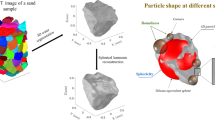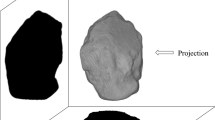Abstract
Available morphological analyses for fine particles are briefly reviewed. Three methods for characterizing morphology of alumina and hydrate are studied in some detail: shape factor by Optomax Image Analyzer, signature by sieve cascadography and Fourier method. The shape factor represents only a global deviation from a circle and does not fully reflect small scale protuberances on the particle profile. The sieve cascadography, when fully developed, can be a useful tool for shape characterization. The commercially implemented Fourier analysis provides information on both global and local shape features by its morphological descriptors which can be used for distinguishing various types of particles. An example is given in which a newly defined “blockiness index” from a combination of Fourier descriptors is used to identify and quantify the blocky alumina or hydrate crystals.
Access this chapter
Tax calculation will be finalised at checkout
Purchases are for personal use only
Preview
Unable to display preview. Download preview PDF.
Similar content being viewed by others
References
J. K. Beddow, Particle Science and Technology, p. 438, Chemical Publishing Co., Inc., New York, N.Y., 1980.
T. P. Meloy and K. Makino, “Characterizing Residence Times of Powder Samples on Sieves,” Powder Technology, 36 (2) (1983), pp. 253–258.
T. P. Meloy, N. Clark, and T. E. Durney, “The Sieve Cascadograph — An Instrument for the Measurement of Particle Shape Distribution,” paper presented at the 9th Annual Powder & Bulk Solids Conference, Rosemont, Il., May 15–17, 1984.
B. H. Kaye, “Specification of the Ruggedness and/or Texture of a Fine Particle Profile by Its Fractal Dimension,” Powder Technology, 21 (1) (1978), pp. 1–16.
H. Schwarz and H. E. Exner, “The Implementation of the Concept of Fractal Dimension on a Semi-Automatic Image Analyzer,” Powder Technology, 27 (2) (1980), pp. 207–213.
B. B. Mandelbrot, Fractals: Form, Chance and Dimension, W. H. Freeman & Co., New York, NY, 1977. (Also, The Fractal Geometry of Nature, revised ed. 1983).
M. Furuuchi and K. Gotoh, “Shape Characterization of Granular Materials from the Residence Time in a Tilted, Rotating Cylinder,” paper presented at Fine Particles Society Annual Meeting, Orlando, Fl., July 30-August 1, 1984.
J. K. Beddow and G. C. Philip, “Fourier Analysis —Synthesis Method of Particle Shape Analysis,” Planseeberichte fur Pulvermetallurgie, 23 (1) (1975), pp. 3–14.
H. P. Schwarz and K. C. Shane, “Measurement of Particle Shape by Fourier Analysis,” Sedimentology, 13 (1969), pp. 213–231..
R. Ehrlich and B. Weinberg, “An Exact Method for Characterization of Grain Shape,” Journal of Sedimentary Petrology, 40 (1) (1970), pp. 205–212.
J. K. Beddow, “Particle Morphological Analysis,” pp. 1–84 in Advanced Particulate Morphology, J. K. Beddow and T. P. Meloy, ed.; CRC Press, Inc., Boca Raton, Fl., 1980.
R. O. Duda and P. E. Hart, Pattern Classification and Scene Analysis, p. 290, John Wiley and Sons, Inc., New York, N.Y., 1973.
C. Chang, “Particle Morphology and Its Effect on Bulk Property,” Ph.D. Thesis, University of Iowa (1982).
D. W. Luerkens, J. K. Beddow, and A. F. Vetter, “Morphological Fourier Descriptors,” Powder Technology, 31 (2) (1982), pp. 209–215.
C. T. Zahn and R. Z. Roskies, “Fourier Descriptors for Plane Closed Curved,” IEEE Trans. Computers, C21 (3) (1972), pp. 269–281.
D. W. Luerkens, J. K. Beddow, and A. F. Vetter, “A Generalized Method of Morphological Analysis (the (R, S) Method),” Powder Technology, 31 (2) (1982), pp. 217–220.
Author information
Authors and Affiliations
Editor information
Editors and Affiliations
Rights and permissions
Copyright information
© 2016 The Minerals, Metals & Materials Society
About this chapter
Cite this chapter
Hsieh, H.P. (2016). Morphological Analysis of Alumina and its Trihydrate. In: Donaldson, D., Raahauge, B.E. (eds) Essential Readings in Light Metals. Springer, Cham. https://doi.org/10.1007/978-3-319-48176-0_101
Download citation
DOI: https://doi.org/10.1007/978-3-319-48176-0_101
Publisher Name: Springer, Cham
Print ISBN: 978-3-319-48574-4
Online ISBN: 978-3-319-48176-0
eBook Packages: Chemistry and Materials ScienceChemistry and Material Science (R0)




